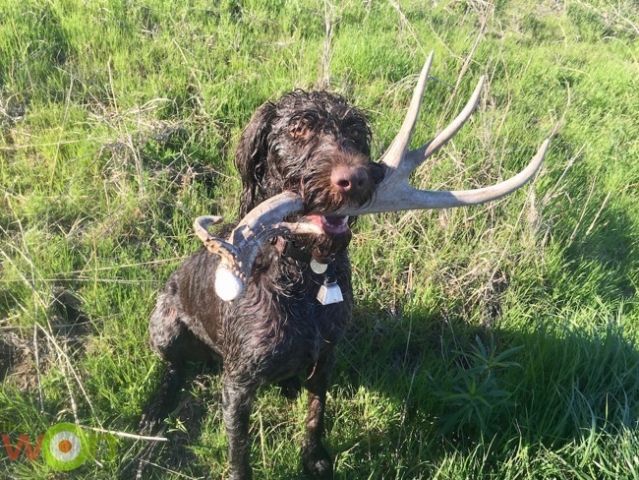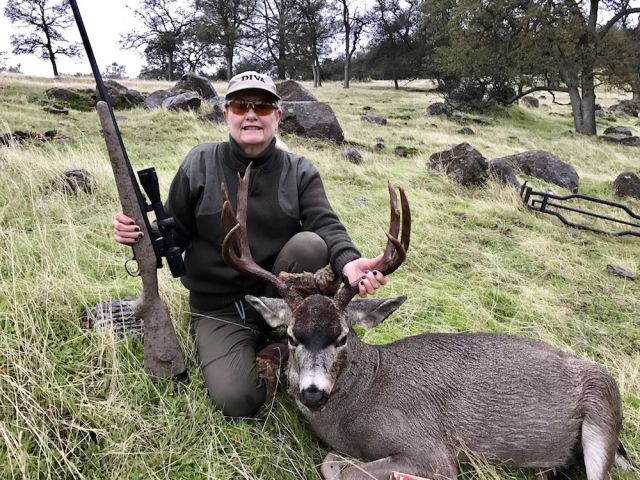Question – now that deer season is over, what is an avid huntress to do? Answer: We go hunting sheds.
Antlers represent the age of mature deer. I began this newfound craze only a few years ago when my dog, Shaka, came into my outdoor life. Prior to Shaka, I would walk pastures, fields and rugged terrain looking for my prize of sheds. Now, I do not have to walk miles and miles looking for sheds and coming up empty-handed.
I introduced Shaka to finding sheds with her powerful nose when she was just 10 months old. Little did I know how rewarding this activity would be for both of us and being one with nature. Shaka lives for the end of deer season, as this is her annual “Easter egg” hunt. There is not a rhyme or pattern to where to look for sheds. Antlers fall off a deer while running, jumping or just walking through the fields.

Wait … what about horns?
What is the difference between horns and antlers you ask? Horns and antlers are very different in their origin, form and function. Horns grow on cattle, big horn sheep and let’s not forget Dagga Boys aka Cape Buffalo and members of the Bovidae family. Horns are permanent and unbranched. Horns usually occur on both sexes. In the living animal, this bony core is covered with tissue that actively produces and outer sheath of keratin – the same material that makes your fingernails. The sheath is never shed off the core, but continues to grow from the base for most of the animal’s life. This growth comes as layers of keratin are added from spongy tissue between the horn core and the inside of the sheath.
The deer family, aka Cervidae, is defined by the presence of antlers. All animals with antlers are members of the deer family and nearly all cervids have antlers. The exceptions to this are a few primitive deer that have long tusks rather than antlers, such as Chinese water deer and musk deer. Deer without antlers are as exciting as tadpoles to this Texas Cowgirl.

Before she went shed hunting, Judy went deer hunting and used a Remington Custom 700 North America in .270, equipped with a Trijicon scope. You can read about her hunting story in an earlier column here at The WON. Click photo to go to the story.
The word antler comes from the Latin antoculorum, meaning “in from of the eyes.” Growing antlers are a spongy bone-like tissue of primarily protein-rich cartilage covered with a hairy skin (velvet). These containers are full of nerves and nutrient-transporting blood vessels. The end of antler growth period, the growth slows and the protein matrix of the antler gets replaced with minerals, such as calcium and phosphorus in a process called mineralization.
So now that we’ve had our science lesson, let’s get out there and find those antlers before the squirrels do.
Did you know?
Antler growth occurs at the antler tips, rather than at the base, at a rate of 1/2 inch per day in some case.
TIP: Antler size peaks in 5- to 7-year olds and usually shrink the following years.
Did you know?
Antlers are the fastest growing tissue in the animal kingdom.
TIP: Let your deer mature with age. Your next year’s antler growth will be a larger trophy on the hoof.
Did you know?
In the fall, testosterone levels in bucks rise, which trigger the drying of the blood vessels in the velvet and stopping of antler growth.
TIP: As tissue has dried, the stripping of velvet occurs rapidly 24-48 hours. You need to be watching the fields while hunting if you want a trophy sill in velvet.
Did you know?
After breeding season is over, dropping testosterone levels in the buck’s body trigger a weakening of the tissue at the base of the antlers which allows the antlers to fall off.
TIP: The ONLY scent on the antlers are at the base or button where the antler is attached to the skull of the deer. This is why a keen nose will find your sheds in the field.
Judy Rhodes, the Voice of Women in the Outdoors is an outdoor visionary and mentor to women and youth in the outdoors. Judy, Founder of DIVA ... Women Outdoors Worldwide is the largest women's ONLY outdoor organization. DIVA WOW is a non-profit 501(c)3 unique all volunteer sisterhood dedicated to encouraging women to discover their outdoor passion. View all posts by Judy Rhodes